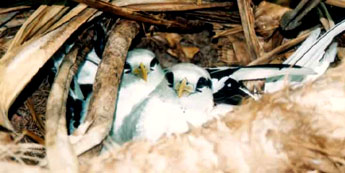|
White-tailed tropicbird, truly an oceanic
bird
November 22, 2004
By BLUEPEACE
Out of the three species of tropicbirds around
the world, only White-tailed tropicbird is found
in the Maldive Islands. White-tailed tropicbird
(Phaethon lepturus) is a graceful tropical
seabird with short black eye stripe and orange
bill, locally known as Dhadifulhudhooni.
Adult birds have mostly white plumage with long,
white, tail streamers (33-40 cm). Dhadifulhu
is referred locally to the long white tail streamers
of the tropicbird and Dhooni to a bird.
White-tailed tropicbird has got very short webbed
legs, their short legs are adapted for diving
and swimming and if it attempt to stand, normally
topple forward, as its legs are placed well
back on the body. White-tailed tropicbirds are
elegant companions of our local fishermen on
the Ocean.
|
A
single grayish-speckled egg is laid on
ground in root base of wild screw pines |
Although White-tailed tropicbird is a common
bird throughout the Maldives, their estimated
population and its nesting islands are not surveyed.
In April 2004, six pairs of known breeding pairs
nested on the uninhabited island Randheli of
Noon Atoll. Around five or six pairs of White-tailed
tropicbirds are a typical number found on an
uninhabited island of the Maldives.
Feeding Habits
White-tailed tropicbird is typically a solitary
feeder, however sometimes seen in pairs. In
Randelhi, in April 2004, White-tailed
tropicbirds were found as a solitary feeder
gliding lonely hunting for squid and fish. As
all the birds were nesting at that time, they
could be hunting solitarily leaving partner
on the nest. White-tailed tropicbirds, in hunting
hit the water and submerge completely to grab
and swallow prey before take off. Some cases
when White-tailed tropicbird take off with the
swallow prey, frigate bird chase tropicbird,
pull its tail streamers, so that White-tailed
tropicbird hang upside down, swollen prey drops
and frigate bird picks the tropicbird’s
prey in the air. A magnificent scene witnessed
by some of our local fishermen.
Breeding
White-tailed tropicbirds begin nesting at four
years of age, and normally nest in small, loose
colonies on uninhabited islands in the Maldives.
Adult pairs perform fabulous display flights
over their breeding islands, and the fluffy
down-covered baby chicks are about as sweet
as birds can get. Courting birds fly in parallel,
with streamers from bird above turned downward
toward mate. Fly together in shallow glides.
 |
Both
parents are on the nest |
Nest year round with peak activity from March
through October. On Randelhi, birds
nest in root bases of wild screw pines (Pandanus
tectorus) and/or other secluded spots.
Randheli is an uninhabited island free from
predator. A single grayish-speckled egg is laid
on ground and incubated by both parents for
about a month; the young are fully fledged about
10 weeks later. Average incubation shift lengths
range from about 4-8 days. Chicks are strongly
brooded for the few days after hatching. Unlike
other sea birds of the same family, adults,
White-tailed tropicbirds regurgitate food by
putting their bills down the gaping chick's
throat.
 |
No
vegetation patches are used by White-tailed
tropicbirds as
air strip to take off and
land |
All the nests on Randheli were built
close to patches where there is no vegetation,
the no vegetation areas are used by White-tailed
tropicbirds in Randheli as air strip to take
off and land after long hours of hunting.
White-tailed tropicbird is a protected bird
in the Maldives; hence, their capture, sale
and captivity have been prohibited. However,
there are no vital conservation measures taken
to protect the nesting habitats of White-tailed
tropicbirds and other birds in the Maldives,
except declaring uninhabited island, Hithaadhoo
in Huvadhu Atoll as protected. Hithaadhoo is
famous for nesting of frigate birds and small
numbers of White-tailed tropicbirds.
|